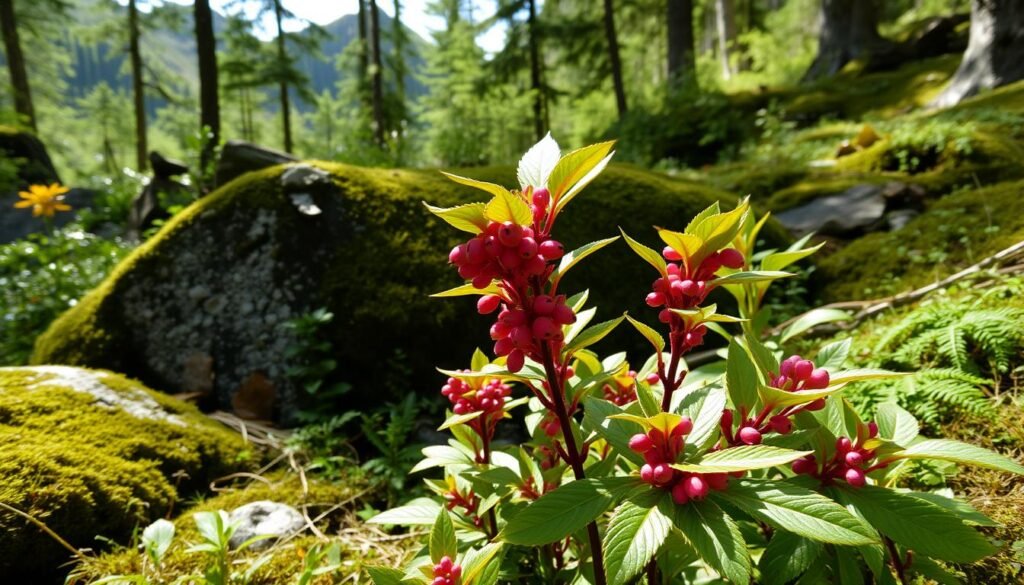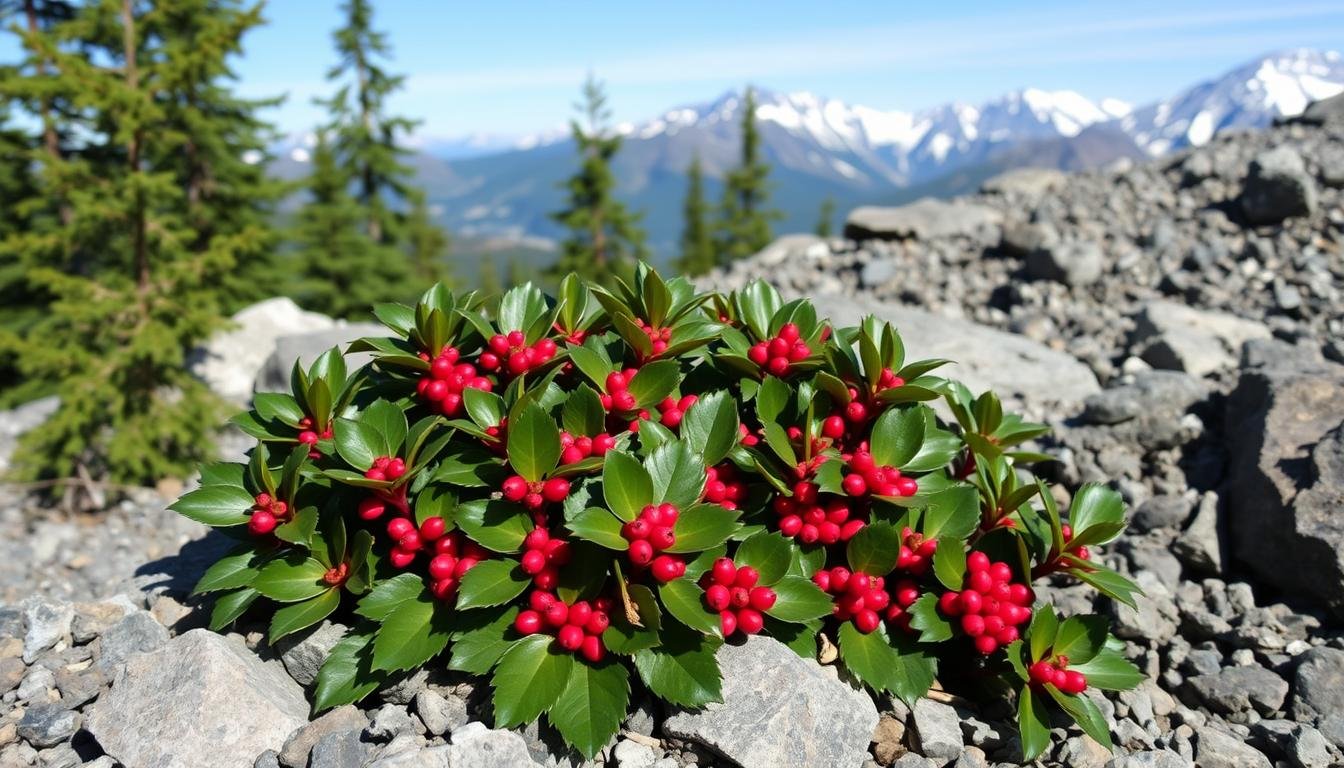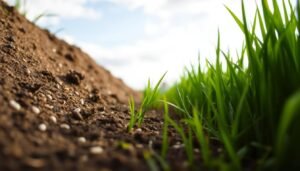The question of can Gaultheria procumbens be found in Alaska is intriguing, as this plant, also known as Eastern teaberry or American wintergreen, primarily thrives in eastern North America. It’s a small, aromatic evergreen with edible red berries, making it a unique addition to any landscape.
When considering if Gaultheria procumbens can adapt to Alaska, we must look at its native range, which spans from Canada to the southern U.S. Alaska’s harsh winters and short growing season present considerable challenges for this plant. This article will explore the physical traits of Gaultheria procumbens, its preferred growing conditions, and its potential to survive in Alaska’s demanding climate. We’ll examine how it might fit into Alaska’s beautiful yet rugged environment.
Key Takeaways
- Gaultheria procumbens is known for its aromatic leaves and bright red berries.
- This plant thrives mainly in the eastern regions of North America.
- Understanding Alaska’s unique climate is vital for assessing the species’ survival potential.
- The native range includes mountainous regions, which pose similar challenges to Alaskan ecosystems.
- Exploring potential habitats in southern coastal Alaska may reveal possibilities for growth.
Table of Contents
Introduction to Gaultheria Procumbens
Gaultheria procumbens is a low-growing shrub known as wintergreen. It grows 10 to 15 centimeters tall. Its leaves are dark green and glossy, smelling like wintergreen when crushed.
The eastern teaberry characteristics are unique. It thrives in acidic, well-drained soils. Gaultheria procumbens loves shady spots in coniferous forests.
In late summer, it produces small, round, bright red berries. These berries are not just pretty. They are full of antioxidants, which are good for health.
These berries are also edible. They add a special flavor to food. This makes them popular in cooking.
The leaves of Gaultheria procumbens have methyl salicylate. This gives them a minty taste. It’s great for herbal tea and cooking.
Wintergreen has a long history of use. It’s valued by Indigenous peoples in Alaska. They use it for digestive health, pain relief, and breathing issues.
Physical Characteristics of Gaultheria Procumbens
Gaultheria procumbens has striking features that make it stand out. It grows low to the ground, reaching 10 to 15 centimeters tall. Its dark green, glossy leaves are oval and about 1 to 2 inches long.
In late spring, small bell-shaped flowers bloom. These flowers add beauty to the plant’s look.
The plant’s bright red berries are a highlight. They are about 6 to 9 millimeters in diameter. These berries taste like wintergreen and are great for cooking.
The plant grows in acidic, poor soils under trees. It shows how well it can adapt to shaded areas.
Wildlife like deer and black bears eat its leaves and berries. This shows how it supports local ecosystems. The leaves are also good for making herbal teas.
It’s important to harvest the leaves carefully. This helps the plant last longer and shows we care for the environment.
For more on plant care, check out an article on the Birds of Paradise plant. It talks about how important the right environment is for plants.
Native Range of Gaultheria Procumbens
Gaultheria procumbens, also known as Eastern Teaberry or Wintergreen, grows in Canada’s north and the U.S. south. It loves acidic soils in forests. It often grows with pines and oaks.
In the U.S., it’s found in states like Alabama, Connecticut, Georgia, and Massachusetts. In Canada, it’s in New Brunswick and Ontario.
The eastern teaberry distribution shows it’s in many places. It grows low, about six inches tall, with dark green leaves and red fruits. It likes woods, clearings, and bogs.
It prefers partial shade but does well in sun with some shade. This shows it’s adaptable.
As part of the alaskan flora, I’m curious about its growth in Alaska. The climate and ecosystem are different. It’s interesting to think about if it could grow well there.
Understanding Alaska’s Climate: A Challenge for Gaultheria Procumbens
The alaskan climate challenges are tough for plants like Gaultheria procumbens. Alaska has very cold winters, short summers, and special ecosystems. Knowing these things helps figure out if Gaultheria can live there.
Temperatures can drop to -40°F. This is very hard for plants not used to such cold.
How much rain falls also matters. Southern coastal Alaska gets enough rain for Gaultheria to grow well. The soil there is acidic, which is good for the plant.
Alaska has five main climate zones. Southern coastal areas might be good for Gaultheria, but the rest is much colder.
| Climate Factor | Impact on Gaultheria Procumbens |
|---|---|
| Temperature Extremes | Vulnerability to harsh winters limiting growth |
| Precipitation Variability | Potential for moisture scarcity but favorable in southern coastal areas |
| Soil Acidity | Beneficial in regions with acidic soils; supports establishment |
| Growing Season Length | Constrained by short summers, inhibiting growth and reproduction |
| Climate Zones | Varies greatly, influencing survival prospects across Alaska |
Even in coastal areas, the climate is still a big challenge. Bringing Gaultheria to Alaska needs careful thought. We must think about the local plants and the risks.
Alaska’s Climate Zones and Their Impact on Plant Survival
Alaska has many climate zones that affect plants like Gaultheria procumbens. These zones include maritime, transitional, continental, arctic, and subarctic. Each zone has its own weather and soil that can help or hurt plants.
Knowing about these alaska climate zones helps us see how Gaultheria procumbens might do. For example, the maritime zone has milder weather and more rain. This makes it good for plants that like temperate weather.
The effects of these climate changes are big. In the Arctic Tussock Tundra, plants face tough conditions. They have short summers and long winters. This area is mostly covered in sedges, showing how hard it is for plants to grow here.
In other zones, like the Arctic Shrub-Tussock Tundra, plants can do better. They have more than 25% cover of small shrubs. But in the Arctic Wet Sedge Meadows, it’s colder and harder for plants to survive. This affects the whole ecosystem.
Looking at these different climates, we see that some places in Alaska might be good for Gaultheria procumbens. But, this plant needs the right weather and soil to grow well. By studying how plants adapt to these zones, we learn more about Gaultheria’s chances in Alaska’s diverse ecosystems.
If you’re into indoor gardening, you might find info on hoya plants interesting. They show how other popular plants can adapt to different conditions.
can gaultheria procumbens be found in alaska

Looking into Gaultheria procumbens in Alaska means checking the USDA Hardiness Zones and finding good places for it. This plant, also called wintergreen, grows well in many places. It’s known for being adaptable.
USDA Hardiness Zones in Alaska
The alaska USDA hardiness zones tell us where Gaultheria procumbens might live. Alaska has five zones, with the south coast in zones 3 to 5. Gaultheria can handle -40°F (-40°C), making these zones good for it.
Potential Habitat Locations in Southern Coastal Alaska
Finding the right spots is key for Gaultheria procumbens to grow. Juneau and the Aleutian Islands might be perfect. Soil, moisture, and tiny habitats are important for it to do well. The variety of southern coastal flora could help Gaultheria spread.
| Location | USDA Hardiness Zone | Potential for Gaultheria procumbens |
|---|---|---|
| Juneau | 3 | High |
| Aleutian Islands | 4 | Moderate |
| Anchorage | 5 | Low |
| Barrow | 2 | Very Low |
Knowing where Gaultheria procumbens fits in Alaska’s habitats is interesting. The south coast of Alaska has the right mix for it to grow and thrive.
Habitat Suitability for Gaultheria Procumbens in Alaska
Looking into the gaultheria procumbens habitat requirements shows where it might grow well in Alaska. This plant likes soil rich in organic stuff and keeps it moist but not too wet. Coastal temperate rainforests seem like a good place for it because of the right soil and moisture.
Soil type is very important. Gaultheria procumbens does best in pH levels that are slightly acidic to very acidic. This helps other plants and animals in Alaska grow too. Also, areas with moist humus-rich soil in the shade or semi-shade are great for it.
It’s also key to think about how it will do with other plants. Gaultheria procumbens needs sunlight and water, especially if it’s competing with other plants. Places like woodland gardens, shady edges, and sunny peripheries are good because they offer less competition.
Places for Gaultheria procumbens must meet its physical needs and how it interacts with local wildlife. Knowing how plants and animals work together in Alaska helps Gaultheria procumbens grow and survive. Studies show it does well in woodlands, where it interacts with native species.
Similar Plant Species to Gaultheria Procumbens in Alaska
In exploring the alaskan flora comparison, we learn about related species. Gaultheria procumbens often grows with other native plants. Vaccinium vitis-idaea, or lingonberry, is one of them. It’s an evergreen shrub that does well in tough climates, just like Gaultheria procumbens.
Vaccinium vitis-idaea grows 8 to 24 inches tall. It has bright red berries that animals love. It grows in sandy, loamy, and clay soils, like Gaultheria procumbens. Both bloom from June to August, helping each other pollinate.
Gaultheria hispidula is another similar species gaultheria procumbens found in Alaska’s forests. It plays a similar role in the ecosystem. These plants help keep ecosystems stable by supporting many species. They feed birds and small mammals, making the food chain stronger.
| Species | Height | Flower Color | Fruit Color | Soil Preference | Native Range |
|---|---|---|---|---|---|
| Gaultheria procumbens | 2-12 inches | White or Pink | Bright Red | Sandy, Loamy, Clay | North America |
| Vaccinium vitis-idaea | 8-24 inches | White or Pink | Bright Red | Sandy, Loamy, Clay | North America, Europe, Asia |
| Gaultheria hispidula | 4-6 inches | White | Red | Sandy, Acidic | North America |
Learning about these similar species helps us understand their environment. This knowledge helps Gaultheria procumbens grow in Alaska’s tough spots. Studying these plants helps us appreciate Alaska’s unique plants more.
Human Introduction of Gaultheria Procumbens in Alaska
Gaultheria procumbens, or American wintergreen, is interesting to people in Alaska. It’s not from there, but some garden lovers might have brought it. They want to grow it in the southern coastal areas. This part talks about the gaultheria procumbens human introduction and the problems it faces in Alaska’s tough climate.
Gaultheria procumbens can grow up to 4 inches tall. It’s a small but special plant for gardens. But, growing it in Alaska is hard because of the short seasons and extreme weather. Alaska’s southern coastal areas might be okay for it, but it’s still a big challenge.
The oil from Gaultheria procumbens is also interesting. It’s used in toothpaste and pain relievers. The plant’s small red berries look like Teaberry gum. But, Alaska’s harsh weather makes it hard to grow this plant outside.
In short, while growing Gaultheria procumbens in Alaska might work in some places, it’s not easy. There are many cultivation challenges to face. So, growing this plant in Alaska’s climate needs careful thought and planning.
Likelihood of Naturalization in Alaska’s Ecosystems
Looking at gaultheria procumbens naturalization in Alaska’s ecosystems is really interesting. It shows how this plant might adapt to a new place. Soil type, local plant competition, and climate stability are key to its success in Alaska.
Some coastal areas might be perfect for it. But Alaska’s tough climate is a big challenge.
At the International Association for Vegetation Science 61st Annual Symposium, important research was shared. It helped understand gaultheria procumbens in Alaska better. The talk was about how natural ecosystems help us see plant distribution. It also talked about how human actions have changed the landscape.
This change makes us wonder about ecosystem shifts and how they affect non-native plants.
Looking at competition, many native Alaskan plants can beat newcomers. It’s important to see how gaultheria procumbens would do against these plants. Especially in coastal areas where it might have a better chance.
In short, gaultheria procumbens might do well in some spots in Alaska. But big environmental challenges could stop it from spreading widely. The battle between native and introduced plants like gaultheria procumbens is fascinating. More research will help us understand how this plant could fit into Alaska’s unique environment.
Conservation and Environmental Considerations
Introducing Gaultheria procumbens in Alaska’s ecosystems brings up big questions. We need to look closely at how it might affect the environment. It’s important to protect plants like Vaccinium vitis-idaea (lingonberry) that are already there.
Alaska has five different climate zones, which can affect how well plants grow. The southern coastal areas might be okay for Gaultheria procumbens. But the harsher interior and northern parts are tougher. We must manage these introductions carefully to avoid harming native plants.
Watching how Gaultheria procumbens affects the ecosystem is key. This helps us make smart choices about introducing it. By focusing on conservation, we can keep Alaska’s unique nature safe. For more info, check out how conditions affect non-native species.
Conclusion
The search for Gaultheria procumbens in Alaska shows an interesting result. The harsh weather and tough terrain make it hard for this plant to grow in most of the state. But, the milder coastal areas in the south might be a place where it could thrive.
This talk about Gaultheria procumbens shows us future exploration opportunities for plants like it. Even though it’s hard for it to survive on its own in Alaska, it can do well in controlled places. This opens up new areas for study and growing plants.
Looking into Gaultheria procumbens and Alaska’s environment makes us think about biodiversity and how ecosystems can change. By learning more, we can understand better how native and non-native plants work together. This helps us know more about Alaska’s ecosystems.




